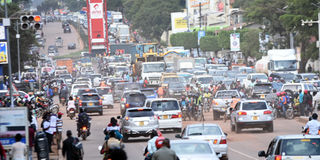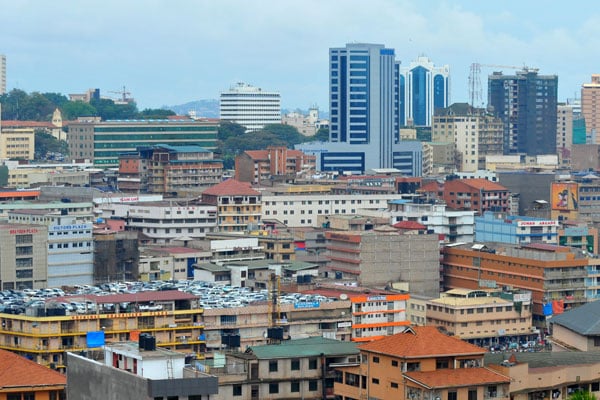Prime
‘Kampala is failing its children on air quality’

Traffic on Jinja Road in Kampala last week. A study conducted by experts from HouseFresh, a British company that interests itself in air quality issues, ranked Kampala as the third most polluted city in Africa. PHOTO/ M. KAKUMIRIZI
What you need to know:
Recent reports by local and international scientists have exposed the deteriorating air quality in Kampala. In this explainer, Tonny Abet reveals just how dire the state of affairs in Uganda’s capital are.
What is air pollution?
Air pollution, according to the World Health Organisation (WHO), is contamination of the indoor or outdoor environment. Air can be contaminated by any “chemical, physical or biological agent that modifies the natural characteristics of the atmosphere.”
In highly polluted areas, the skyline can become hazy and people may sense unpleasant odours. But this depends on the kind of pollutant in the area, prevailing temperature and humidity. Sometimes the sky can appear blue and clear yet the pollution is high.
The length of exposure to polluted air, the age of the person exposed and prevailing health condition of a person, are some of the main determinants for developing complications due to pollution.
Pollution can predispose people to or exacerbate respiratory diseases such as asthma, heart (cardiovascular) ailments and diabetes.
How bad is the situation in Kampala?
A study conducted by experts from HouseFresh, a British company that interests itself in air quality issues, ranked Kampala as the third most polluted city in Africa. Globally, Kampala capital came eighth.
Kampala’s main pollutants include dust from unpaved roads, and emissions from motor vehicles, motorcycles and industries that are springing up in the metropolitan area.
Around 70 percent of roads in the capital city are unpaved. Most of the estimated two million vehicles and 1.4 million motorcycles that ply these dirt roads are old and have poor combustion of fuel. These automobiles release pollutants that harm people, plants and the soil.
The other sources of pollutants are smoke from wood fuel, and burning domestic solid wastes for people who cannot access or afford to pay for rubbish and waste collectors. This is worsened by the fast increase in the city population. Waste collectors take the wastes to designated centres for proper management and recycling.
Pollutants of major public health concern include particulate matter (PM), carbon monoxide, ozone, nitrogen dioxide and sulfur dioxide. PM refers to very tiny or invisible pieces of solids or liquids which are suspended in the air around us. This may include dust, soot and dirt.
Mr Waiswa Ayazika, the head of environment monitoring at the National Environment Management Authority (Nema), says information from the air quality network in Kampala indicates that the last seven months have on a daily basis witnessed air quality that is largely within moderate and unhealthy zones. This means the air is not clean.
The air pollution recorded in all of Kampala was more than five times higher than the WHO tolerable limit, Mr Waiswa warns.
What do local experts have to say?
Prof Engineer Bainomugisha, the Airqo project lead, says we should be deeply disturbed when fine particulate matter (PM2.5) levels are high. Airqo manufactures low-cost air quality monitors at Makerere University.
PM2.5 means the particle is 2.5 microns or less in diameter. This is the equivalent of breaking a millet seed into 800 tiny pieces. PM2.5 is commonly found in smoke. They are small enough for you to breathe them deeply into your lungs. The particles can enter your bloodstream. They are associated with heart failure and lung diseases.
People who are sensitive to air pollution might experience symptoms when PM2.5 levels are high. These symptoms can include wheezing, coughing, chest tightness and difficulty breathing.
The other PM, which is also of health concern, is PM10. This is a coarse particle that is 10 microns or less in diameter. This is the equivalent of breaking a millet seed into 200 tiny pieces. PM10 can cause irritation to the eyes, nose and upper airways.
So is it only fine particle matter we should dread?
Not really. Dr Ivan Kimuli, a physician at Makerere University Lung Institute, warns that there are “other contaminants of air such as ozone, carbon monoxide [that] induce airway inflammation.”
Oxidative stress is another cause of concern. Chemicals known as oxidants take away oxygen from our bodies and turn them into dangerous particles that can damage our organs.
“Ozone also causes airway hyper-responsiveness. Here, if you pass by someone wearing perfume, your airway responds by getting mucus. A person [with asthma] gets into an exacerbation,” Dr Kimuli explains.
Unfortunately, the levels of dangerous pollutants have continued to rise over decades in Uganda as industrialisation increases and more people buy vehicles.
“Good air is critical for the health of human beings, animals and the earth,” says Mr Waiswa Ayazika, the head of environment monitoring at Nema.
Dr Daniel Okello, the Kampala Capital City Authority (KCCA) director for public health, says he is equally concerned about pollution in the city and how to curb it.
“Air is free,” Dr Okello says, adding: “It is a gift to us—the gift we give to people coming after us is to maintain that air clean. We are killing our grandchildren.”
Is Kampala equipped with infrastructure to monitor its air quality?
Dr Okello says Kampala has a good network of air quality monitors that can help you see air quality levels. He says the data has been important in planning for clean air in the city.
“We have around 100 air quality monitors, but we started with 20. On our website [of KCCA], it will show you where the monitors are and the results are colour-coded,” he says.
He explains that in the colour code, green will show you that the air quality is good, amber will tell you that the air quality is moderate and red will tell you the air quality is bad.
What impact has the poor air quality had on health?
Dr Kimuli warns that rising asthma cases in Uganda could be due to rising levels of air pollutants such as the PM2.5. Asthma arises from genetic predisposition, but environmental factors such as air pollution are key in asthma causation and exacerbation. The Lung Institute expert says children are some of the most affected by air pollution.
Dr Kimuli says: “133,000 people are dying from asthma in one year out of 4.9 million people affected by the disease [in Uganda].”
He adds: “Living in urban areas and use of bio-fuels is associated with asthma. PM2.5, according to past assessments, was high, exceeding 100 microgram per cubic centimetre in urban areas of Kampala.”
Dr Okello says nationally, in 2020, around 22,000 died due to HIV/Aids. “But for diseases associated with air pollution such as cardiovascular diseases, lung diseases and diabetes, we lost 26,000 people,” Dr Okello says.
However, there is no clear study that determined the exact number of deaths directly linked to air pollution in Uganda, according to experts at Makerere University Lung Institute.
What about the global picture?
Referring to data from the WHO, Mr Waiswa notes that globally, about 7.2 million die of air pollution every year. He adds that 4.2 million people die due to outdoor air pollution and 3.8 million others die from indoor air pollution—mainly as a result of poor combustion and biomass that we use in cooking.
“Many of us go to the village and our relatives cook indoors with firewood, which has a lot of smoke. That is indoor pollution,” explains Dr Okello.
For outdoor air pollution, especially in the capital city, Dr Okello says it is even worse.
“When we are at a traffic stop in the morning, have you ever counted how many boda bodas are actually at that stage? Maybe they are around 100-150, yet none of them has a catalytic converter. Some of them, oil and petrol mix and they burn together,” he narrates.
The director adds: “What happens there is bad emission and our monitors are showing, that is outdoor pollution.”
Does the situation improve under Kampala’s night skies?
No. Dr Okello says the air quality in the city is just as bad at night.
“What we found is that many people burn their rubbish at night when they return home from work,” he reveals, adding, “Also, people roast meat and cook with methods that release a lot of smoke.”
So, what are the action points?
“We need to service our vehicles and boda boda regularly [to reduce emissions], avoid idling while in traffic jams,” advises Dr Ivan Kimuli, a physician at Makerere University Lung Institute.
He adds: “We should walk and cycle as opposed to driving, we should use masks when entering polluted zones, proper disposal of wastes instead of burning [pay waste collectors].”
The expert also advises city dwellers to use cleaner fuels like gas cookers and electricity, have good ventilation in the house and also plant trees to absorb some of the pollutants in the air.
Dr Daniel Okello, the Kampala Capital City Authority (KCCA) director for public health, on the other hand, says: “Parliament is looking at a way to regulate importation of old vehicles, we want those [vehicles] with catalytic converters to reduce emission.”
Mr Waiswa Ayazika, the head of environment monitoring at the National Environment Management Authority says actions include working with urban authorities like KCCA to ensure roads are tarmacked, reducing traffic jams, promoting mass transport, non-motorised transport and use of electric vehicles or motorcycles.
“We need to control the population of the city [by developing other cities and availing public services]. We need to continue sensitising the population about air quality, causes and dangers,” Mr Waiswa advises.




